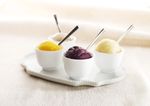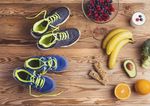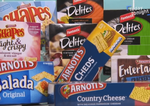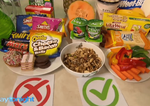The sneaky sugar in 'healthy' drinks
by Anne Finch, Accredited Practising Dietitian for LiveLighter
- November 12, 2015
- Leave a comment
- Marketing
- Healthy eating
- Top Tips
- Mythbusting
- Sugary drinks
- Shopping
- Goal Setting
- Junk Food
- Sugar
- Smart Swaps
- Drinks
- Nutrition Facts

It’s pretty obvious that soft drinks aren’t a healthy choice. But what about some of the other drinks that market themselves as a better choice?
Sports drinks
Most Australians don’t ever need to drink a sports drink. Ever. They can have around 9 teaspoons of sugar per bottle!
Have you noticed the funny straws or mouthpieces on sports bottles? They’re so athletes can squirt the drink down their throat and minimise contact with their teeth. When your mouth is dry (like when you’ve been exercising heavily), the sugar gets more stuck around your teeth and increases your risk of dental decay. Rinsing your mouth after drinking a sugary drink is recommended.
If you’re doing more than 90 minutes of intense exercise, or have lost a lot of fluid through heavy sweating, vomiting or diarrhoea, a sports drink or electrolyte replacement drink may be a useful option. Otherwise, regular water and the electrolytes present in normal food will do the hydration job just fine.
It’s always nice to finish with some examples. So here are some activities that don’t need a sports drink:
- a 40 minute gym session
- a hangover
- a child’s tee-ball game
- a social volleyball game
- cycling to work
Some activities where you may want to consider a sports drink:
- eight-hour day roofing in Kalgoorlie in the summer
- triathlon training
- playing a full game of AFL
- explosive diarrhoea
Juice, fruit drinks and smoothies
Juice: Whole fruit is a great snack choice. Yes, there’s sugar in fruit, but it’s bundled up with fibre, vitamins and antioxidants. So what happens when you juice a fruit? You squeeze all the sugar into a glass and throw away the fibre, which is the best bit.
A glass of orange juice contains about six oranges. You’d be pretty full after eating six whole oranges, but it’s easy to slurp down the juice and a lot of extra kilojoules. So while an occasional small glass of juice can give you some vitamins and antioxidants and count towards your recommended daily two serves of fruit, you’re better off having the whole fruit.
Fruit drinks: these can be confusing as they often claim to be fruit juice, but contain very little actual fruit (and therefore vitamins and antioxidants), and often contain added sugar. These go in the same category as soft drinks. They are not an everyday drink.
Smoothies: Haven’t smoothies made a huge comeback in the last couple of years? Smoothies use the whole fruit or vegetable – fibre, pulp and all – so they are usually a better choice than juices and can be a good way to include fruit and veg in your diet if you’re struggling to fit it in. Smoothies made with whole fruit and veg and low fat milk (or milk alternatives) and no added sweetener (like sugar, honey, maple syrup, rice bran syrup etc.) are your best bet. Keep an eye on the size though. Again, liquid kilojoules don’t usually fill us up as much as food.
Flavoured milk
If you read the nutrition panel on your average choc milk, you might be stunned to find that a 600 mL drink contains around 60 grams of sugar – that’s 13 teaspoons. The thing to remember is that in Australia we don’t distinguish between naturally occurring sugar in foods and added sugar in nutrition panels. Milk naturally contains lactose, which is a type of sugar. It gets included in the nutrition panels as sugar, but gets processed differently by your body than table sugar.
600 mL of plain low-fat milk has about 36 grams (or eight teaspoons) of lactose in it. That means that a large choc milk has around 5 teaspoons of added sugar. That’s not great, but it’s not as disastrous as 13 teaspoons! Milk also has a lot of nutritional benefits – it’s a good source of calcium and protein, which helps you feel full.
Coconut water
There are a lot of health claims made about coconut water that are not supported by scientific evidence. I blame clever marketing for this. If you’re after a sweet drink, it’s a better choice than a soft drink because it’s got about half the amount of sugar.
I’m talking about the juice straight out a young coconut here. If you’re having the packaged kind, check for added sugar. This might be listed in the ingredients list as regular ol’ sugar, or something else, like fruit juice concentrate, rice bran syrup, glucose, malt extract or many more.
The verdict
Drink water. Eat fruit and vegetables in their whole form. Check the label to make sure you’re getting what you think you’re getting. Don’t fall for the marketing hype.
Our sugary drinks calculator can help you to calculate how much sugar you’re guzzling each week, and how much weight you could be putting on each year just from drinks. Give it a go!







